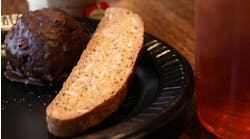The research has been clear for years: Even when it comes to comfort foods like baked goods, consumers are concerned about healthy eating. The COVID crisis has accelerated that issue, as people who are isolating at home worry about adding pounds.
“The shift in consumer shopping habits caused by COVID-19 is finally moving back toward what has been a longstanding central focus for many consumers: incorporating well-being into every facet of their lives, especially the foods they eat,” notes CJ McClellan, senior manager, global marketing, for Corbion.
“The demands for better-for-you foods and healthy ingredients have risen steadily in recent years, contributing to the popularity of baked goods containing whole and ancient grains. And while we recognize that taste, texture and value remain important to consumers, when these qualities are married in a food that offers health perks as well, they can more readily give themselves permission to purchase an item.”
Fortunately, ingredient suppliers are now making it easier than ever for baked goods manufacturers to create the better-for-you products consumers are seeking. They are offering pretreated grains, easy ingredient mixes and other solutions to facilitate healthy commercial baking.
“Due to the events of 2020, consumers are doubling down on proactively supporting their health through balanced, wellness-forward diets,” notes Paula Labine, marketing director, baking, milling and starch, at ADM. “They are increasingly interested in healthy foods that help them feel good, but don’t want to sacrifice on aspects like quality and taste. Opportunities for innovation exist in formulations featuring fiber and nutrient-dense ingredients like whole grains and plant protein.”
Sara Lee Soft & Smooth was launched back in 2005, when Sara Lee Corp. was its own company. It was perhaps the first whole-grain bread that looks and tastes like white bread, giving consumers, particularly kids, the health benefits of whole grains with the taste and texture they love. This Sara Lee brand is now part of Bimbo Bakeries USA.
A challenging swap
Consumers love to see whole grains, ancient grains, high-fiber, high-protein and other healthy-sounding phrases on baked goods labels. But commercial bakeries can’t just swap out a sack of processed wheat flour for a sack of millet – recipes simply don’t work that way.
For example, whole grains absorb more water than refined grains, which means formulations including whole grains tend to have a higher moisture content and produce stickier doughs, explains Kelly Toups, director of nutrition for Oldways Whole Grains Council. Sticky dough can slow down production line speeds, she adds.
“For the best results, you can’t just take out the white flour and substitute whole grains," she says. "Reformulation will often require more moisture, letting the dough rest before kneading (allowing time for the flour to absorb the additional moisture) and in some cases a longer fermentation period.
“It is also helpful to remember that one size doesn’t fit all. A particular variety of whole wheat might make terrible bread but make beautiful pasta dough, or vice versa,” Toups adds.
Grains other than wheat – such as quinoa, oats and amaranth – are often desirable ingredients for flavor and health benefits; but because they do not contain gluten, adding such grains can create difficulties in some applications. Toups explains that the gluten found in wheat, rye and barley helps dough stretch and rise, so leaving those grains out can negatively impact certain recipes.
“That said, gluten-free flours can usually be substituted for about 25 to 30 percent of the flour in a conventional baking recipe without requiring any other major changes to the recipe,” Toups says.
The challenge of swapping in healthier ingredients exists also in sweet goods, especially considering functional ingredients like eggs and butter. If a bakery wants to make a healthier chocolate cake, the baker needs to address how to replace traditional ingredients without affecting the consumer experience of the final product.
For example, ingredient supplier Puratos has created mixes for cakes, brownies and donuts that use plant-based ingredients instead of eggs and butter, making them suitable for consumers seeking to avoid those animal products. Developing those mixes required research and development energy.
“The proteins found in eggs and dairy play a crucial role in creating texture and structure in a cake,” notes Jessica Blondeel, senior product manager for patisserie at Puratos. “When formulating our plant-based cake and brownie mixes, we used our unique enzyme solutions and a blend of flours, starches and proteins to recreate the texture, structure and mouthfeel consumers are used to in traditional cakes and brownies.”
Making it easier
As Puratos has done for cake mixes, several suppliers have developed mixes that make it easier to incorporate healthier ingredients in baked goods.
Ardent Mills’ Net Carb Application Mix, for example, is a wheat-based product designed to reduce the overall carbohydrates in baked goods. The company uses a proprietary extraction and blending process to create the mixes, which are non-GMO, dairy-free, vegan and no-sugar-added.
The Net Carb Application Mix was “developed to be used in a range of bakery and snack applications – from breads to pizza crusts to snack crackers – and is ideal for consumers who are interested in managing their net carb intake,” says Don Trouba, senior director, go-to market, for The Annex by Ardent Mills.
“Net carbs are calculated by subtracting total grams of fiber and sugar alcohols, if present, from total carbohydrates. Many low net carb foods to date have lacked craveability and the taste experience consumers expect. Gluten-based ingredients like our Net Carb Application Mix have been optimized for breads, buns, pizza crusts and crackers, but can be used in other baked goods with adjustments.”
Corbion offers a selection of premixed and pretreated grains – some including up to eight different grains – that contain the right moisture balance to keep breads moist and fresh, McClellan says.
“These versatile, easy-to-use grains can be added directly into existing formulas or right on top before baking, in order to create new varieties of baked goods without the expense of reformulation,” McClellan adds. “The result is an attractive artisan-style baked good that features delicious flavor and irresistible crunch.”
Another example of a healthy grain additive is Softgrain from Puratos. These blends of grains and seeds are presoaked and infused with sourdough and can be added directly to existing bread recipes.
Softgrain Multigrain CL, for example, includes rye, wheat, oat, teff and millet grains and flax seeds; and Softgrain Sweet 5 Grain CL is a blend of oat, sunflower seeds, millet, flax seeds and wheat, plus sugar and honey.
“There are no special manufacturing requirements to use Puratos’ Softgrain product,” says Alex De Los Reyes, associate product manager, baker mixes, improvers and health & well-being for Puratos. “You can add the product to your mixer and adjust your recipe a little depending on the amount of liquid you have. It’s much easier than adding the grains otherwise.”
Beyond grains, ADM has developed protein and probiotic ingredients designed to enhance the healthiness of baked goods. For example, ADM’s Arcon T textured pea protein – which comes in two varieties, one with pea and chickpea protein and another with pea and navy pea protein – improves the texture and density of baked goods while boosting protein levels. And the company’s HT-BLP1 ingredient, which results from heat-treating the probiotic BPL1, targets metabolic health.
“HT-BPL1 is uniquely tolerant to harsh processing conditions and is better suited to the baked goods category than live probiotics since probiotics do not survive as living microorganisms after baking,” Labine says. “HT-BPL1 can be added at any stage of the formulation process as it is more tolerant during processing as a postbiotic.”
How much does it really matter?
Do the additions of these healthy ingredients ultimately improve the health of consumers? Yes, according to people who know.
“With whole grains you get a bigger nutritional bang for your buck,” Toups says. “For example, compared with refined or enriched wheat, whole wheat has 28 percent more protein, three times more potassium, three times more zinc, four times more fiber, and six times more magnesium.
"People who regularly eat whole grains are more likely to live longer lives and have healthier gut microbiomes, and are less likely to develop heart disease, colorectal cancer, and other health problems,” she says.
And these days it’s easier than ever for consumers to determine whether a product contains healthy ingredients or not. De Los Reyes notes that not only can grocery shoppers read the label, but today they can also point their smartphone at a product’s barcode and get simplified nutritional information through the Fooducate app. This app rates products on a letter scale from A to D based on calories, sugar, trans fats and other characteristics. A low rating can turn off buyers, she says, so suppliers should see where their products stand.
Corbion’s McClellan agrees, but adds that overall experience still matters: “Over of half of consumers say they pay attention to food ingredient labels, and 33 percent say they've increased their research on ingredients.
"Statistics like these may seem alarming to bakers or cause them to believe that the ingredient labels of their products are the most important factor for consumers, but the reality is more nuanced. Meeting the demands of consumers requires a delicate approach, one that takes into account their clean-label demands but balances it with taste, texture and appearance.
"Ultimately, the best course of action is to determine which health factors are most important to consumers," sums McClellan, "and create products that meet these requirements, while still delivering on taste and quality.”


